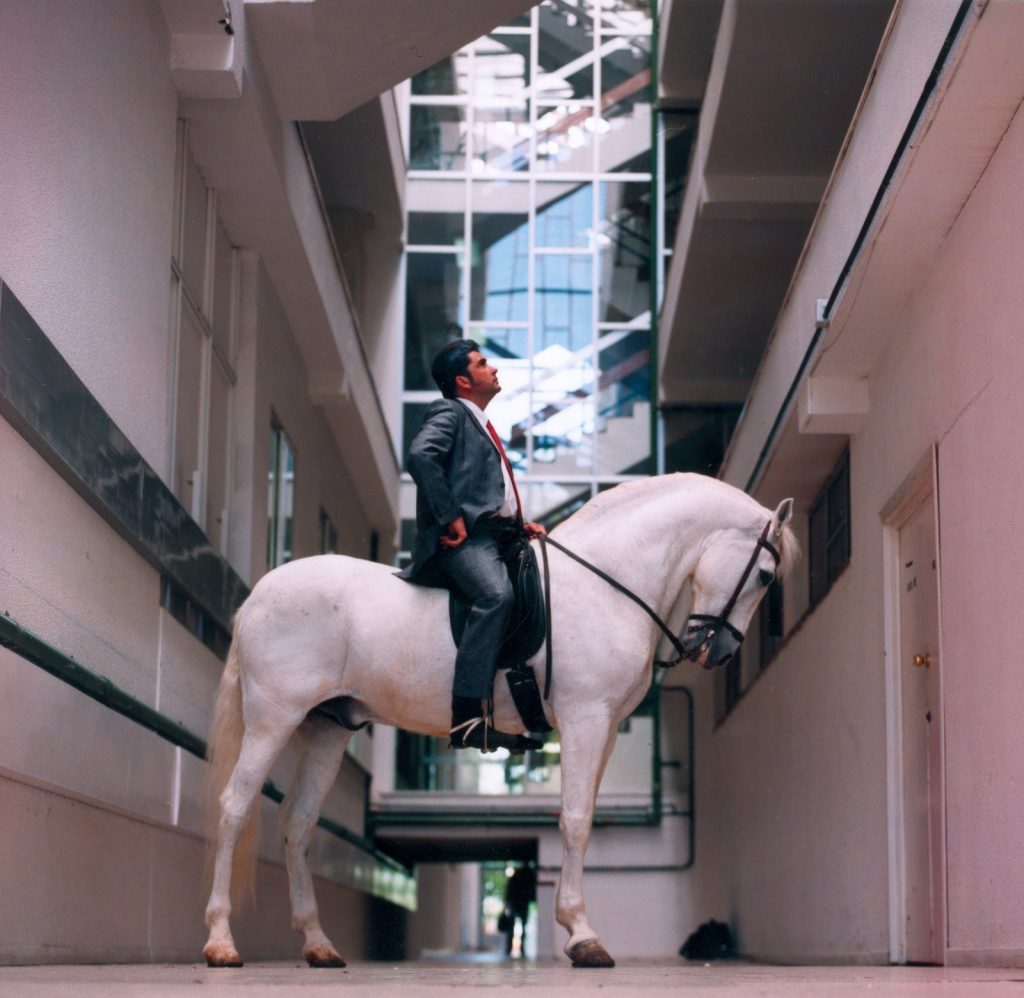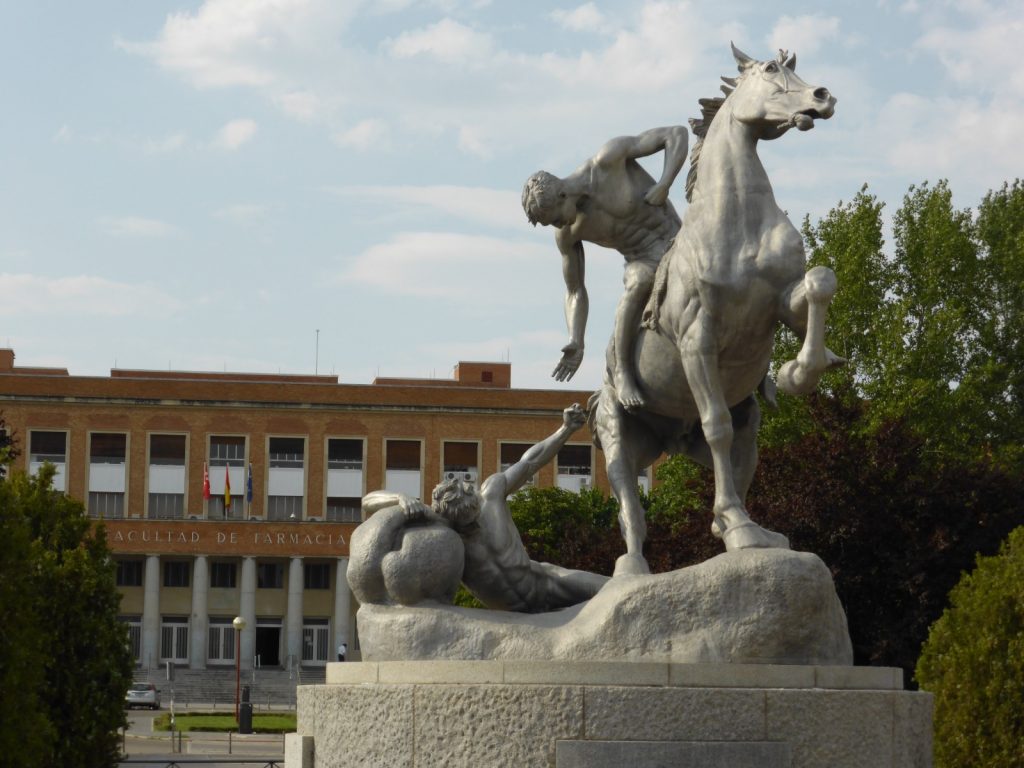Interrupting the hurried pace of a contemporary art festival. In between talks, performances and lectures, Hito Steyerl generously spent a few minutes with us to answer some questions about the current state of the university.
Archivo Orsini: The Universidad Autónoma de Madrid was moved to the outskirts of the city to remove the student body from the urban center. The building appears to have a rationalist, Bauhaus, crystalline and transparent style. However, this aura of modernity quickly turns into a panopticon where everyone sees everyone else. The interior is organized by narrow corridors that end in right angles and multiple staircases that prevented the mobility of young people in times of revolt. Also, the unit of measurement taken into account to design the space was not that of the average student, but that of a mounted guard. The university is a space where the one who feels most comfortable is the policeman. The students of the Universidad Autónoma quickly found a solution to demonstrate: throwing marbles on the ground, whose bounces frightened the horses and made it difficult for the police to move. Taking this story as a symbol. What are the marbles of our future? What could be the way to escape the mediums of surveillance in the university?
Hito Steyerl: I think, first of all, probably the first way of stop this is preventing the construction of such places in the first place… okay in Madrid this seems to be done, so marbles seems to be the answer… But I think that one of the decisive moves was the transformation of the student as a person that needs to learn something and is a member of society into a short of product or commodity, also into a person from whom can be extract rent from, a person from whom can be extract fees from, that becomes, such as speak, an opportunity for making profits. I think this is a part of neoliberal transformation of education that seems to be out in Europe for the past 20 years, and to reverte to the reasonable idea of students as people that co producing knowledge with other people and are not just cattle that are not supposed to be herded by mounted policeman inside haussmannian university corridors that would be one demand.

A.O.: Following with horses, anecdotes and Madrid, I wanted to tell you another story.in the mid-20th century, an aluminum sculpture was placed in Ciudad Universitaria representing the university spirit: on a horse, a muscular young man picked up the torch of civilization that a fainting athlete could barely keep off the ground. This torch represented culture, that which is the subject of the university. It is interesting to see how culture, information, in the university is only transmitted, nothing is modified, nothing is changed, nothing is added or subtracted. Everything remains the same, everything is permanent and stable. The university seems to be reduced to its communicative condition. Perhaps the only thing that changes is the speed of transmission: before the immobile athlete the fast horse. Likewise, it is amusing to see how over the years the torch has disappeared. It was stolen. Now maybe the sculpture is more honest, they don’t even pretend to pass something on anymore. Do you think this is real, that the university is only a space where the relay is passed, where criticism is absent? How could this reality change?
H.S.: I think is a fascinating story, especially the missing torch, the torch that is supposed to stand for knowledge, that is supposed to stand for the promisian spirit of the human that take the knowledge from the gods, so after the robbery its no more knowledge it seems, just gods. Also it is interesting to look at those bodies, between whom the passing knowledge is somehow missing… you see these muscular bodies of young males basically between whom the missing knowledge is passing and that is also part of the story. We have a very, very narrow stage for imagining how knowledge is suppose to be transmitted and at what kind of velocity. There is no knowledge to be passed on.

A.O.: In addition to your work as an artist, you have been a professor at the Berlin University of the Arts for years, where you teach experimental film and video. You are also co-founder of the research group: Research Center for Proxy Politics at the Berlin University of the Arts. On a personal level, how do you experience this issue? Do you recognize from a personal and intimate point of view any problem in this institution that you would like to share or change?
H.S.: Since the pandemic, the condition of teaching has massively change. We see, at universities, through all Europe, or at least in my country, a profound exhaustion of the student body in terms of resources, material resources of course, lack of money, lack of jobs during and after the pandemic, but also mounting mental health issues. That’s a situation that, of course, its not good for any kind of learning because it has become more about securing the basics resources for survival. Visa is a good example. All shorts of permission to pacified bureaucracy to give people, at least, some subsidies to being able to continue the studies. So this is what my job has been transformed over the past few years. I am a short of assistant bureaucrat now trying to get people in touch with mental health providers. At the moment is zero knowledge, or research, or art production going on at all because the student body has been completely depleted through this pandemic austerity/inflation. And also war, just to remember.
A.O.: It’s a matter of surviving.
H.S.: Yes, it’s become quite basic these days.
A.O.: These days we are having an intense debate about the university and its systems. The narrative seems to have a great confidence in progress. Also about art and its networks. As you said in one of your texts to criticizes the complex economic system that vertebrates the art market world: the value is not in the product but in the networks. In that case you spoke negatively of these networks, connected by nodes such as gossip, rumor, interests and marketing. However, in other contexts these networks act as lifelines. University seems to have lost this lifelines, this networks. It became, as we have seen, a unsolvable place. So, against the linear progress concept there is other idea: let the university colapse and build other institution from the ground. Maybe this point of view is too cynical, too naive but it has gain popularity. What do you think?
H.S.: Universities still has a roof, a roof is not a bad thing, it protects people from the rain a provides a meeting point. Of Course, nowadays many universities are subjected to a very narrow economic interest, and we have a even more radical situation in the art market, but is not to say, as you mention, that all networks of knowledge, of learning are wrong, there are extremely good places to meet and exchange. Instead of abolishing the university I think the conversations is more about restoring the function of being a learning place, also a teaching place, a place for exchange…
A.O.: The last question. While reviewing some documentation to prepare for this short meeting I came across the infamous Art Review Power100 list in which you appear ranked on 11 occasions. In 2022, you where the forth of the ranking under something that they named “UNIONS”. Far from wanting to deepen on this issue I would like to use this anecdote to introduce a problem that you comment harshly in some of your works and is also present in the university. The issue I am referring to is the tokenization and gamefication of life, in which academics are franked by a system of points depending on their publications and their appearances in outside journals and citations. Also, these journals are ranked in importance by private American companies… The loop is infinite and evil. Is there a way out of this loop? And if everything is a game, can we play by different rules, can we change the goal, can we play not to obtener the maximums points?
H.S.: First of all, the metrics are completely insane and wrong. Tokenization is a very important issue that I have being considering from very different points of view because, by coincidence, it is very important for new technology, like the blockchain and cryptotoken, but also machine learning, artificial intelligence, and in quantifying language. Tokenization is a process of quantification of everything, of value, of language, of identities, and of course of money. Tokenization is finding some short of benchmark to compare and exchange everything with everything else but also putting a value to basically everything. And the metrics by which this is done are of course rigged, they are subject to economic interest. Tokenization is a key process of this contemporary moment, in technology but also in economics. I think that the short natural way in which this is disguise as progress has to be dismantled. I am not your token.